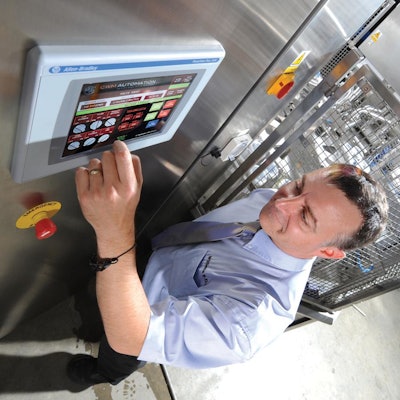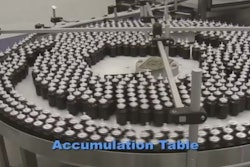
Although integrating hydraulics and pneumatics with electronic controls certainly has its advantages, it can also bring a number of challenges. Because many machine designers lack the training and experience necessary for surmounting them, some automation vendors are packaging electronic actuators to mimic hydraulic components.
A case in point is the servo technology that Milwaukee-based Rockwell Automation has packaged to look and behave like hydraulic cylinders. Because of their servo actuation, these cylinders are programmable and capable of extending and retracting with precise positioning, speed and force.
“In addition, engineers can clevis, trunnion and flange-mount electric actuation to the load with the same style of rod eyes and clevis attachments used with pneumatic and hydraulic control,” notes Jim Gegg, global product manager at Rockwell Automation. “As a result, the machine designer requires no new training.”
This precision was crucial for a volumetric filling and dispensing machine that CWM Automation Ltd. in Gainsborough, U.K. designed for a new line of soup being introduced by TSC Foods Ltd. of Scunthorpe, U.K. Because the soup was to be sold in pots rather than sachets or cans, it presented a number of problems for high-speed, high-volume packaging equipment. “Even the thickest soup is still very runny,” notes Mick Williams, managing director of CWM Automation. “For this reason, it is difficult to package into pots quickly without spilling and splashing the product everywhere.”
His engineering staff had tried a number of approaches in the past, including servos, pneumatics and simple mechanical systems. Pneumatic technology jerked too much, and the mechanical approach did not offer the flexibility to modify the process later, Williams said. Consequently, the engineers at CWM turned to their counterparts at Rockwell Automation for help in developing a servo-based approach using the electrical cylinders.
In its final form, the soup-packing machine has a rotary table with 12 sets of four pockets. Each pocket holds a pot, and the machine indexes each set of pockets around until it is under a filling head that dispenses the product. Once filled, the pots are removed and have their lids added before being loaded onto an exit conveyor.
Besides using the electric cylinders, the filling machine also relies on an Allen-Bradley CompactLogix programmable automation controller, an EtherNet/IP network, and servo drives. “We can have multiple axes all running at different speeds,” says Williams. The machine can also be tailored to suit a variety of products and packaging concepts, providing the agility demanded by the market.
Williams at CWM Automation is not the only one who is seeking to improve control over the motion of his machinery by replacing pneumatic cylinders with servo-based technology. “We were just talking to a manufacturer who has been having problems with performance as the air pressure changed throughout the facility,” says Robert Muehlfellner, director of automation technology at B&R Industrial Automation Corp. based in Roswell, Ga. The resulting vibration and excess motion were affecting repeatability and causing wear on the machinery.
Because continual manual tweaks and installing pressure reducers were not rectifying the problem, their discussion was about replacing the pneumatic cylinders with linear motors and actuators. Made by LinMot Inc. of Elkhorn, Wis., these electromagnetic devices are permanently actuated synchronous servomotors that consist of only a stator and a slider. B&R relies on its AcoposMicro servo drives to integrate this technology into its drive portfolio.
Besides being simpler and more precise, these actuators also tend to be more energy efficient than pneumatic cylinders. Muehlfellner estimates that they are usually more than 90 percent energy efficient, whereas the overall efficiency of a pneumatic system is about 30 percent of the energy put into it.
Although pneumatic devices are simple and less expensive to buy and install than most of their electric counterparts, the technology is a kind of one-way street. “You have to compress the air and transport it throughout the facility,” explains Muehlfellner. “Then you just use it. Once you do, it’s gone. You can’t reuse it.” For these reasons, he urges users to consider the total cost of ownership over the life of the equipment, not simply the initial purchase price.
>> Click here to read Automation World's full coverage: Fluid Power Gets Smart by Adding Electronic Controls.


























